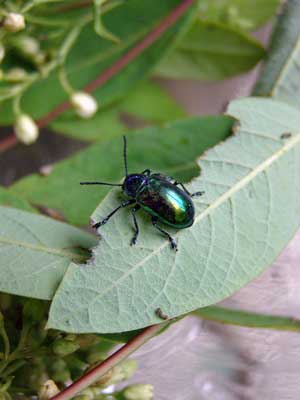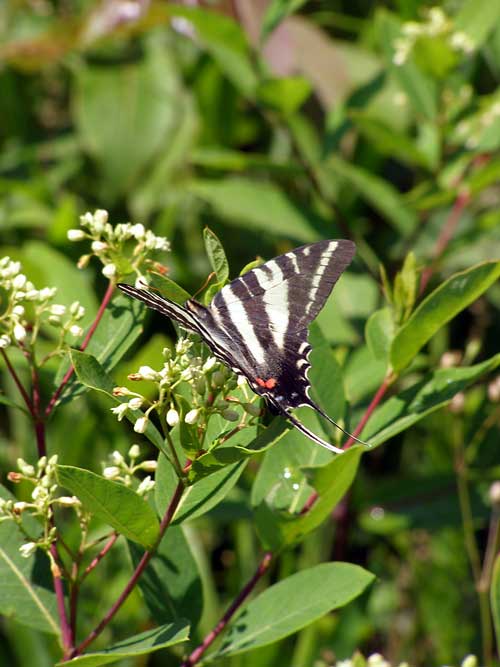A very engaging plant

Though not a pollinator, the iridescent dogbane beetle depends on Indian hemp to survive. Photo by Ken Moore.
By Ken Moore
Flora Columnist
I have a new favorite plant, Indian hemp, Apocynum cannabinum, sometimes called dogbane because the milky sap is poisonous and is unsavory to dogs, who usually like chewing anything.
I featured it in Flora back in June of 2008 after being stopped in my tracks by the beauty of raindrops balanced on the paired leaves attached to the red stems.
Indian hemp was of great utilitarian value to Native Americans. No, they didn’t smoke it; they had better sense. They made use of the strong silky fibers of dried stems harvested in the fall to make cordage. Patiently weaving those silky threads by hand, the cordage products ranged from fishing line to strong rope, garments and moccasins. The dried and powdered roots were used for a number of medicinal purposes.
Next time you encounter the plant, or rather a stand of the plant (because, being rhizomatous, it makes great colonies), gently break off a leaf. You will observe a milky-white droplet at the breaking point. Be inquisitive and let a bit of that sap stick to a fingertip; after a few seconds, touch the fingertip with your thumb. Glue-like, it will tend to hold them together. Make certain you wash that sticky substance off and don’t dare taste it! Definitely don’t encourage children to play with it.
That sticky, milky sap must hold the secret to the strength of those fine silky fibers that became so useful to early Americans. There is great interest these days in reconnecting to the heritage of cordage; it has become a popular part of nature camps and outdoor environmental education programs. Even adults become passionate about it.
The reason I’m newly hooked on this plant is because of the diversity of flying and crawling critters it attracts. You can become mesmerized for long stretches of time. Though common along roadsides and fields everywhere, it’s easiest to examine the large colonies of Indian hemp in the fields of Mason Farm, where weekly walks bring weekly discoveries.
Countless insects and sometimes birds explore and settle on the surface of leaves and clusters of tiny white flowers. Some of those critters are pollinators, some are laying eggs on the host plant to serve the appetites of hatching larva and some are lying in wait to make a meal of unsuspecting others.
I couldn’t believe the beauty of the iridescent dogbane beetles, so plentiful a couple of weeks ago. There are a few still lingering. They hang around for only a couple of weeks, intent on mating and laying eggs on the undersides of the leaves. Hatching larvae bury into the ground and feed on the plant roots until emerging as adults next year. Beetle populations never seem too large to harm the plants.
The beautiful zebra swallowtail is frequently observed foraging on the short white flowers. They are obvious pollinators. Now I’m curious to observe which of all those other hovering critters may also be pollinators.
June 21-27 is National Pollinator Week. Celebrate the great diversity of pollinators with a walk to Mason Farm or some other field to check out all the action.



Comments are closed.